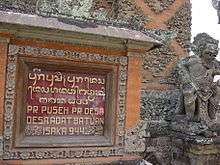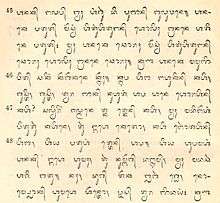Balinese language
| Balinese | |
|---|---|
|
ᬪᬵᬱᬩᬮᬶ, ᬩᬲᬩᬮᬶ1 Basa Bali, Bhāṣā Bali1 | |
|
| |
| Region | Bali, Nusa Penida, Lombok and Java, Indonesia |
| Ethnicity | Balinese, Bali Aga |
Native speakers | 3.3 million (2000 census)[1] |
| Latin, Balinese | |
| Language codes | |
| ISO 639-2 |
ban |
| ISO 639-3 |
ban |
| Glottolog |
bali1278[2] |
Balinese, or simply Bali, is a Malayo-Polynesian language spoken by 3.3 million people (as of 2000) on the Indonesian island of Bali as well as northern Nusa Penida, western Lombok and eastern Java.[3] Most Balinese speakers also know Indonesian. Balinese itself is not mutually intelligible with Indonesian but may be understood by Javanese speakers after some exposure.
In 2011, the Bali Cultural Agency estimated that the number of people still using the Balinese language in their daily lives on the Bali Island does not exceed 1 million, as in urban areas their parents only introduce the Indonesian language or even English, while daily conversations in the institutions and the mass media have disappeared. The written form of the Balinese language is increasingly unfamiliar, and most Balinese people use the Balinese language only as a means of oral communication, often mixing it with Indonesian in their daily speech. But in the transmigration areas outside Bali Island, the Balinese language is extensively used and believed to play an important role in the survival of the language.[4]
The higher registers of the language borrow extensively from Javanese: an old form of classical Javanese, Kawi, is used in Bali as a religious and ceremonial language.
Phonology
Vowels
| Front | Central | Back | |
|---|---|---|---|
| High | i | u | |
| Mid | e | ə | o |
| Low | a |
The official spelling denotes both /a/ and /ə/ by a. However, a is usually pronounced [ə] when it ends a word, and [ə] occurs also in prefixes ma-, pa- and da-.[5]
Consonants
| Labial | Dental | Palatal | Velar | Glottal | ||||||
|---|---|---|---|---|---|---|---|---|---|---|
| Nasal | m | n | ɲ | ŋ | ||||||
| Stop/Affricate | p | b | t | d | tʃ | dʒ | k | g | ||
| Fricative | s | h | ||||||||
| Approximant | w | l | j | |||||||
| Trill | r | |||||||||
Stress
Stress falls on the last syllable.[5]
Grammar
The word order is similar to that of Indonesian, and verb and noun inflectional morphology is similarly minimal. However, derivational morphology is extensive, and suffixes are applied to indicate definite or indefinite articles, and optionally to indicate possession.[5]
Registers
Balinese has different registers depending on the relationship and status of those speaking: low (basa ketah), middle (basa madia), and high (basa singgih). Basa singgih contains many loanwords from Sanskrit and Javanese.
Numerals
Balinese has a decimal numeral system, but this is complicated by numerous words for intermediate quantities such as 45, 175, and 1600.
Writing
Balinese has been written in two different writing systems: the Balinese script, and in modern times the Latin script.
Balinese script

Note: The script is arranged in Javanese order.
The Balinese script (Aksara Bali, ᬅᬓ᭄ᬱᬭᬩᬮᬶ), which is arranged as Hanacaraka (ᬳᬦᬘᬭᬓ), is an abugida, ultimately derived from the Brāhmī script of India. The earliest known inscriptions date from the 11th century AD.
Few people today are familiar with the Balinese script.[6] The Balinese Script is almost the same as Javanese script.
Latin alphabet
Schools in Bali today teach a Latin alphabet known as Tulisan Bali.[7]
Gallery
 Balinese palm-leaf manuscript
Balinese palm-leaf manuscript Sign at Pura Puseh Temple, Batuan, Bali
Sign at Pura Puseh Temple, Batuan, Bali Page from a Bible printed with Balinese script
Page from a Bible printed with Balinese script Street sign in Singaraja, written in Latin and Balinese script
Street sign in Singaraja, written in Latin and Balinese script- Klungkung Regent's Office sign
Note
^1 In Balinese script, Sanskrit and Kawi loanword has different orthography than native words. The first Balinese script is influenced by orthography of Sanskrit and Kawi as word basa derives from the Sanskrit word भाषा bhāṣā. Meanwhile, diacritics is not written in current romanization of Balinese language. Thus, ᬪᬵᬱᬩᬮᬶ and basa Bali are the standard forms.
See also
References
- ↑ Balinese at Ethnologue (18th ed., 2015)
- ↑ Hammarström, Harald; Forkel, Robert; Haspelmath, Martin, eds. (2017). "Balinese". Glottolog 3.0. Jena, Germany: Max Planck Institute for the Science of Human History.
- ↑ Ethnologue.
- ↑ "Balinese language 'will never die'". March 30, 2012.
- 1 2 3 Spitzing, Günter (2002). Practical Balinese: Phrasebook and Dictionary. Rutland VT: Tuttle Publishing. p. 22.
- ↑ Omniglot.
- ↑ The Balinese Languages by Fred B Eiseman, Jr – Bali Vision
External links
| Balinese language test of Wikipedia at Wikimedia Incubator |
- Balinese man speaking Balinese language in different Balinese dialects
- Ager, Simon. "Balinese". Omniglot. Archived from the original on 9 March 2007. Retrieved 2007-03-07.
- The Balinese Digital Library.
- Widiadana R. A. & Erviani N. K. (29 January 2011). Ancient ‘lontar’ manuscripts go digital. The Jakarta Post.
- Erviani N. K. (14 January 2011). US scholar brings ancient Balinese scripts to digital age. The Jakarta Post.
- http://unicode-table.com/en/sections/balinese/
- Paradisec open access recording of Balinese song.
- Kaipuleohone's Blust collection includes materials on Balinese, including RB2-006, RB2-009.